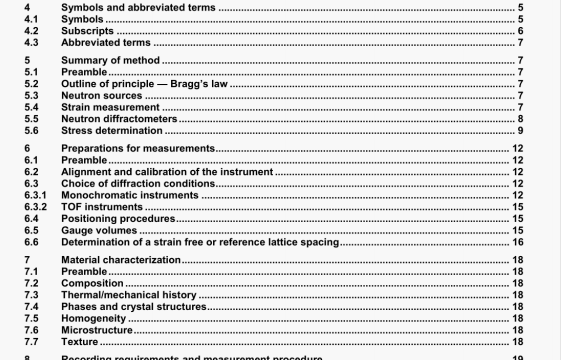ISO/TS 21432 pdf download – Non-destructive testing -Standard testmethod for determining residual stressesby neutron diffraction.
6 Preparations for measurements
6.1 Preamble
Prior to an actual strain measurement it is necessary to align the instrument and/or verify its alignment. Then appropriate conditions far the diffraction measurement have to be chosen and the specimen has Lu be positioned accurately on the diffraction Instrument. Also the size and shape of the volume from which diffraction will be observed have to be determined, and the value has to be assessed of the S-spacing with respect to which the strain will be determined.
6.2 Alignment and calibration of the instrument
Ifs necessary to align and cibrate the diffrac*ometet being used (see A.4.2,i. When using a rrionochromahc beam Instrument, It Is necessary to ensure that a constant wavelength is maintained throughout the entire set of measurements and that the detector angular response has been calibrated (see EN 13925-3:–3) Annex C). At a TOF-diffractometer, both the flight path and detector angular response should be calrated, In both cases this is done using a standard stress free specimen typically silicon. cena or alumina powders. Such specimens are chosen because they diffract neutrons well, have known and well defined lattice parameters and have smal intrinsic peak widths. If intensity information is required at a TOE instrument it is necessary to determine the incident neutron flux and the detector efficiency as a function of wavelength One way or doing this is to use an incoherent scatterer, such as vanadium.
6.3 Choice of diffraction conditions
6.3.1 MonochromatIc Instrum.nts
6.3.1.1 Choice of wavelength
At monochromatic instruments the user shall choose the neutron wavelength for a particular expenment from the range of wavelengths available. The wavelength and diffraction plane should be selected such that efficient execution of the experiment is achieved for a diffraction angle near 90, However, if the chosen wavelength is dose to twice the d-spaclng of any diffraction plane in the specimen, Bragg edge related spectrum distortion can occur Which can cause artificial peak shifts, These ‘problematic’ wavelengths have been tabulated in for several common metals over a range commonly used for strain measurements. For cubic materials, In particular. scattering angles of 9O should be avoided since for aM (kAJ) diffraction planes there is an alternate (I, k!’) which would cause a Bragg edge related effect.
The efficiency with which a measurement can be performed depends on parameters such as incident beam intensity at the chosen wavelength, diffracted neutron intensity, peak width and separation of peak under mvestigation from adjacent peaks. With respect to these factors a diffraction angle quite different from 90 may be more efficient than one close to 90.
Plastic deformation begins at different stresses recorded by the load cell in differently oriented grains, as illustrated in Figure 7. This is demonstrated by a non-linear response on loading followed by linear elastic unloading. The consequence is that a different residual elastic strain may be measured on each Ml plane on unloading to zero applied stress. These are usually called inlergranular strains. Far no remainmg load on the test bar, the engIneerIng (macroscopic) residual stress shall be zero to satisfy equilibrium conditions, Nonzero residual strains at zero load for any crystallographic plane will translate into a residual stress Consequently it Is important, for engineering residual strain measurements, that a crystallographic plane is chosen which gives essentially zero residual strain on unloading [e.g plane (220) or (311) In Figure 7J
If a suitable Ml plane is not known, or a new material is being examined, an appropriate plane can be determined by loading a tensde bar into the plastic region as shown in Figure 7.
Nevertheless, in some cases it is necessary and appropriate to employ hAl planes that are sensitive to lntergranular strains. In such cases compensation has to be made for the lritergranular strains. One suitable approach is to obtain the d0-value from coupons that are taken from the specimen under investigation and are sufficiently small not to contain macrostresses . Examples of hAl planes with high and low sensitivity to intergranular strains for a range at materials are listed in Table 1.
ISO/TS 21432 pdf download – Non-destructive testing -Standard testmethod for determining residual stressesby neutron diffraction
